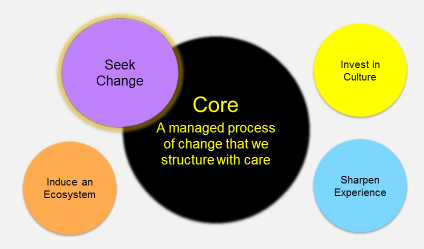Posted by Caveo Learning ● January 19, 2017
Cohesive Learning Curation: Building the Core of L&D

The concept of curation may seem out of place in the learning & development world—it’s a term from visual arts that is now being used (some would argue misused) across the culture. But thinking about curation is perhaps just what L&D needs to exercise the proper selection and care of the learning objects and materials in our purview. A curator’s mindset can be used to engage perhaps the most neglected, even missing, part of many curricula: the core.
The curation of the core can be a way to invest in culture, make learning more experiential, and to induce a learning ecosystem. Just as importantly, curation can be used to reform the core as way to foster managed change.
But let’s begin with a story from far outside L&D that shows us the nature of a symbiotic curation...
Each summer evening in Austin, a crowd gathers on and around the Congress Avenue Bridge and in boats on the Colorado River to watch some 750,000 pregnant Mexican free-tailed bats leave their holds on the bottom of the bridge for the night’s hunt.
The nightly flight of the bats is an illustration of the countless acts of inadvertent and mutual creation; as humans leave their imprint on the natural world, so too do other species in turn affect us. The bridge, it turns out, is the perfect shelter, as the gaps along the bottom are easily entered by bats, but are too small for predators. Inside, the bats cling together in warmth and security before departing along the practiced route to the tree line in a seeming nod to humans entering an interstate at rush hour. The bridge and bats combine to form a resilient ecosystem that illustrates how companionship can exist, across species, in unlikely places.
We'll return to this scene in a moment, but let’s first attend to the business at hand.
Curating the Core in L&D
Curation is popping up everywhere. The snack display at the local coffee shop suddenly bears a sign saying that the nut bars and hipster Pop-Tarts are “curated” for the customer's appreciation. Authors such as Steven Rosenbaum’s Curation Nation proclaim “content curation” a new way of working that is the basis for the sharing economy. It ultimately boils down to three simple steps: identify, organize, share.
 Where does this leave L&D? While we may turn against the curation wave—do we really have to be “curators” on top of everything else?—surfing it allows us to turn our attention to the most neglected, yet central, of learning objects: "the core." While attention to the core is essential to any single L&D program or deliverable, let’s consider it at the curricular level as the center of learning for the organization. What is your core? What common, purposeful message, story values, system, or mindset do all learners receive from L&D? And, who “owns” this message—that is, who creates and controls it? To what extent is it purposeful, evolving, cared for, curated?
Where does this leave L&D? While we may turn against the curation wave—do we really have to be “curators” on top of everything else?—surfing it allows us to turn our attention to the most neglected, yet central, of learning objects: "the core." While attention to the core is essential to any single L&D program or deliverable, let’s consider it at the curricular level as the center of learning for the organization. What is your core? What common, purposeful message, story values, system, or mindset do all learners receive from L&D? And, who “owns” this message—that is, who creates and controls it? To what extent is it purposeful, evolving, cared for, curated?
A curational mindset for L&D can help us reclaim and remake the core as a learning-centered process of transformation. The graphic above shows four nodes for recasting the core, culminating with forming the core as a process of managed change.
Engineering a Core, Building a Culture
Let’s follow the progress of a single company, a multinational engineering and technology firm, through the nodes. Like many companies, this one spent vast productive energies building a learning periphery, including a corporate university with various tracks and career learning paths selecting from hundreds of course offerings. Impressive. The core, however, was harder to articulate. It was almost tangible (“We all know what the company is about”), but unstated in L&D (“We’ve got the core values hanging on the wall. Do we really need a course?”).
 Instead, this company discovered that it needed a learning culture, a way of helping all employees understand a unique mindset and way of working. Stakeholders came to this realization slowly, partly with the help of consultants who could see the interesting differences that set this company apart. They identified the company’s core around a unique process for team-based collaborative decision making that allowed them to maximize opportunities and prevent mistakes. It is, as they now say, “a decision-based company.” Articulating this vision was the first step to a working core.
Instead, this company discovered that it needed a learning culture, a way of helping all employees understand a unique mindset and way of working. Stakeholders came to this realization slowly, partly with the help of consultants who could see the interesting differences that set this company apart. They identified the company’s core around a unique process for team-based collaborative decision making that allowed them to maximize opportunities and prevent mistakes. It is, as they now say, “a decision-based company.” Articulating this vision was the first step to a working core.
Next, they considered how the core was introduced to and experienced by the teams of employees, new and old. The process needed to be a living story and path of action that could be told, retold, shifted, and examined. Working with consultants, the learning professionals at the firm built this core and spread its impacts like tentacles across the organization. They rebuilt curricula around the decision process and its many related stories and cases. They adopted transformative technologies, such as a learning record store, which helped to transform the company into a learning organization where nearly every activity was a way to further experience and reflect upon the treasured decision-making process at the core. They came to see that a “thick” lived learning culture could thrive only when it became an ecosystem to which all parts contributed, including everyone at the company and their activities, building a capacity for deeper engagement with the process and its results.
This was all very good… but it was not enough, for the core itself needed to change.
Complementarity and the Transformed Core
Despite its precision and relative reliability, the vaunted decision-making process had blind spots. Mistakes were made. Projects proved difficult. Decisions were called into question through “look-back” assessments. L&D worked with the company’s decision analysts to examine the data and articulate root causes. In the end, it came down to one key term: uncertainty. While we may think of the engineering world as a place where precise knowledge is applied, uncertainties abound; the world is complex, and even math is imperfect. Engineering may be defined as a mode of approximation in chaos that must be made reliable if this curated human world is to survive.
For L&D, uncertainty was unsettling and wondrous. It was the exact opposite of what had been built for years, a system for learning to produce the best approximations, the most certainty. It illustrated quite beautifully a principle of complementarity in core design. While a learning core should take us in a certain direction, its complement should be incorporated as well. Identification of the complement is the key to transforming and enriching the core, as it leads us deeper to a place of connection. In “classic” curation, exhibits are built through complementarity as different pieces resonate with each other, conveying a common story more powerful than any piece alone can tell.
This brings us to roost with the bats in Austin. Their story is similarly one of complementarity, as a bridge becomes habitat and home, and the evening commute leads the city’s other residents to their night’s vocation. Austin, wisely (and as they say there, weirdly) cultivates culture around the bats, an even more complicated ecosystem that involves architecture, trees, tourists, music, and the river that sustains the web.
At the engineering firm, the complementarity of uncertainty transformed the core. L&D seized the opportunity to redefine the decision process itself as a way of engaging, explicating, assessing, and quantifying uncertainty. It had always been a way for working with uncertainty, but now this dimension became clear. The SMEs and IDs are now leading the way to incorporate a multifaceted meditation on uncertainty through the learning ecosystem. Curation, in this case, was a way of seeking and managing change.
What needs to change in your core?
Topics: Learning Strategy

